About my (cargo) bike
June 19, 2010
I started riding much more seriously back in 2006, unhappy with my crappy blood chemistry, feeling fat, not particularly fond of the oil war that we were in, and global warming. I knew I could ride my commute — 10 miles — in good weather, not carrying much, but what about bad weather? What about shopping? What about kids?
What clinched the deal, was a few months after starting to ride in earnest, my blood chemistry improved, lots. Can’t quit now, right? So I didn’t, and set out to do whatever it took to keep riding. The bike I ride now is the result of this, and it is now a really excellent bike, probably more fun to ride than any other bike I have ever owned.
So why is it fun? It goes fast enough, it handles well, I can carry pretty much anything I can pick up, and because of the tires, steel frame, and the seat located midway between the tires, bumps are not so much of a problem. I can go into a sort of a tuck for the wind, I can ride upright and see everything, I can easily do a rolling dismount. It’s really stable; I come much closer to being able to do a track stand, and the bike tends to stay upright when I clip minor obstacles (don’t ask). If I don’t ride, I start to hurt; my knees like regular use, and there’s something funky (arthritis, is the unofficial diagnosis) going on in my back, that biking fixes.
Like all bicycles, parking is never a problem, like all bicycles, traffic is not much of a problem. Like all bicycles, if I find my way blocked by a giant snow pile or some similar obstacle, I get off and go around or over (try that in a car sometime). If it breaks, usually you can fix it on the road with hand tools. If it breaks badly (it did once) you can easily walk it home, or at least to a better place to wait.
My first bike in this effort was a Specialized hybrid, upgraded with a FreeRadical from Xtracycle. I used this for three years, and wore out the front fork. I tried numerous handlebar experiments along the way. I upgraded to a Big Dummy frame from Surly, and for that upgrade tried several more experiments, which generally worked.
The gear in back is the standard set of Freeloaders from Xtracycle, except that I built my own Snapdeck out of slightly thicker marine plywood, and applied many coats of spar urethane to protect it. The freeloaders easily carry six standard-sized grocery bags. I also attached a taillight (1 watt red-orange power LED) glued to some aluminum hollow square stock, and a great big reflector/mud flap so that the bike is unusually visible.
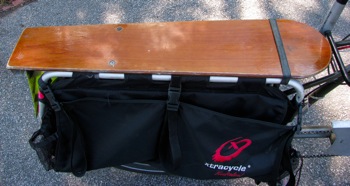
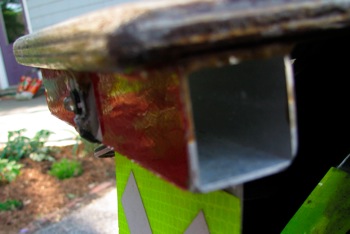
The tires, front and rear, are 2.35″ Schwalbe Big Apples, run at 60 psi, which is their rated pressure. Each tire has a manufacturer-rated load of 150 kilograms (330lbs). They have low rolling resistance, and do not get trapped by most cracks and slots that might be in the road. They also protect the wheels from potholes, which can dent rims (did that), or even crack bearings (son did that, on his bike). For visibility, they have reflective sidewalls.
The rear hub is (now) an internally geared Shimano Alfine 8-speed. This is a replacement for a 9-speed SRAM iMotion, which has a wider range and more evenly spaced gears, but which also locked up solid after 3000 miles of use, which is unacceptable. The Alfine works well, and is dead silent, which is a nice plus, but the range is probably not quite enough, not for a cargo bike. I have dreams of getting the Shimano 11-speed that is coming out this fall; I am not sure I am ready for a Rohloff, and those are famously unquiet (at least in some gears). Quiet is interesting, but the Rohloff is said to be most-reliable.
Update: I’m getting the Rohloff. I repeatedly torqued loose the axle nuts on the Shimano, I may have done some damage to it. I experimentally added an oil port, that was not so good — leaky, because I added too much oil. The Rohloff lets me get the low gears I sometimes need, while still leaving a 10% margin from the no-lower-than-this input gearing.
The saddle is a Brooks Flyer, a relatively narrow leather saddle with rear springs, to help with bumps in the road. I like leather saddles, this works for me, some people don’t. Under the saddle, is a Nitto tandem stem (a bit of Old Stock that was hanging around Wheelworks, my local bike shop) and a stoker bar, for passenger(s).

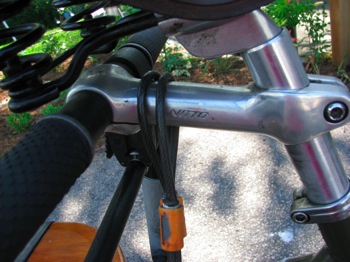
The crank is a Sugino track crank, attached to a narrow Phil Wood bottom bracket. My goal, in getting an internally geared hub, was to use only one chain ring in the front, with the pedals as close together as possible (small “Q”) and a full chainguard to protect my shoes and pants from the chain. This all worked, fabulously.
New mods to the chaincase, over the subsequent year:
The pedals are a recent innovation. I used to use cleats all the time (see old picture above), which meant, no riding in “normal” shoes, or clogs, or flipflops, or barefoot. I learned about MKS EZY pedals (they are detachable, in seconds) and got 3 of them, so that I can shuffle pedals from bike to bike, as it suits me. Normally, on the cargo bike, I carry rubber treaded pedals, and cleats, and leave my most thief-friendly bike with no pedals at all. This was a great experiment-that-worked.
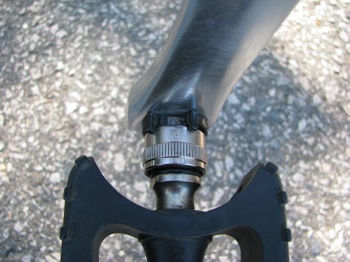
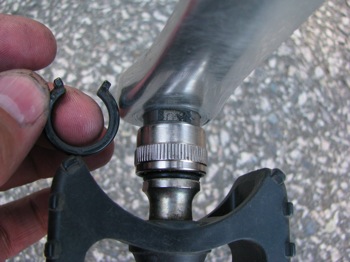
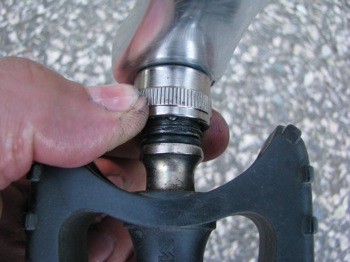
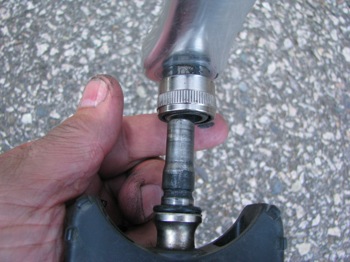
The handlebars are weird, but they work. I had been using dropped bars, but was feeling a bit stretched out, and wanted to be able to sit up more sometimes (it helps to vary both hand positions AND back positions). But I also often found myself on my hoods, if not on the drops. What to do? So, I bought some Velo-Orange Montmartre, which are narrow, made of road-sized tubing (they now also come in MTB gauge), have a straight-back section for hand grips, but also have a bend in front where I could put the hoods.
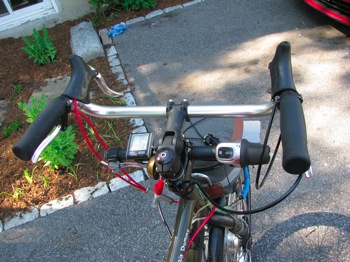
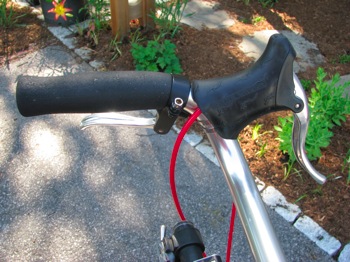
To get brakes in both places, I added interrupter levers, using one as intended, but one with a Problem-Solver 2-into-1 brake cable converter. The 2-to-1 converter works better.

I have since replaced the interrupter with a 2-to-1 converter. It does work better.
Because I am not interested in bending over like a pretzel, I did not cut the fork at all, and instead have a reduced-sized handlebar to carry all the junk that is usually attached to handlebars.
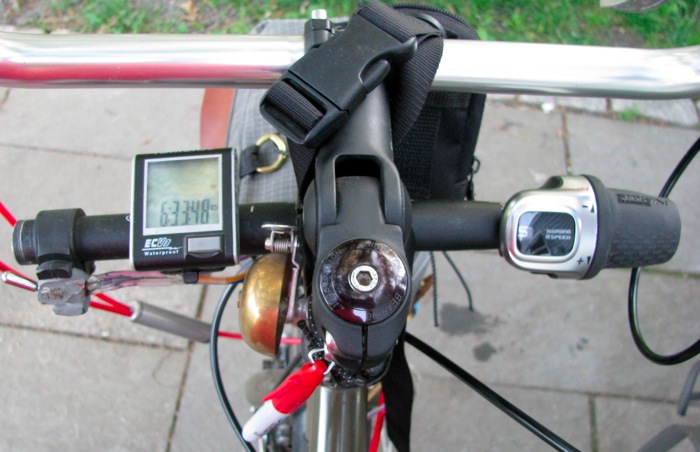
From left to right, the high/low-beam switch, the bicycle clock/speedometer/odometer, bell, and on the right, the shifter.
The lights are also custom. I built my own controller, and it runs the taillight, a running light (yellow), and front high and low beams, all LEDs. The low beams are yellow, the high beams are white, both are one wide lens and one spot, under a mirrored “hat” to help keep the light out of pedestrians’ eyes.

So, what to do if you want to do the same, but are not sure you are ready to spend two or three thousand dollars on a bike and accessories? I think your two choices are either to start with an Xtracycle FreeRadical, because most of that gear (with the exception of the Hoodie/LiteLoader) can upgrade over to a Big Dummy if you decide that you like cargo bikes and want a stiffer (and heavier and more durable) frame, or you go with a Madsen, which doesn’t have the upgrade path, but appears to be a decent bike, doesn’t require as much bike-mechanical fiddling, and has that big bucket for carrying your kids.


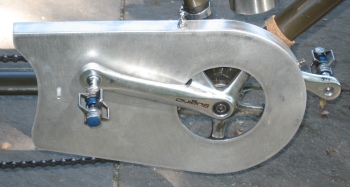

July 22, 2010 at 10:45 pm
I use those MKS AR-2 pedals on a folding bike. Since I fold the bike at least twice a day, and time is of the essence, I don’t use those plastic clips. No problems withthe pedals coming off on their own- ever- in over 10,000 miles. Bearings need overhauling every couple thousand miles, though.
Very nice cargo bike. I had the blood chemistry problem when I turned 50, and the daily commute has done wonders.
Ciao!
Steve
LikeLike
January 22, 2012 at 12:23 pm
[…] ride it into Cambridge when the conditions are not-too-bad, because it is (far) less valuable than my cargo bike. However, I get tired of carrying stuff on my back, so I decided to add some cargo ability to it. […]
LikeLike